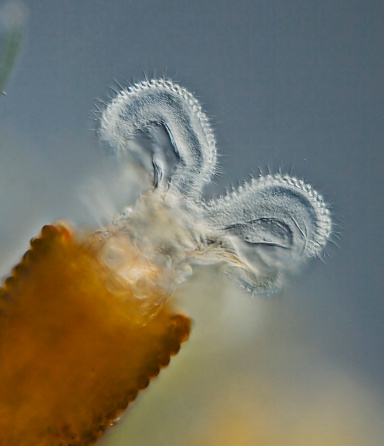
Rotifers are pretty small animals, but they are rather complex for their size. Rotifers have bilateral symmetry. Recall that, unlike asymmetric or radially symmetric animals, bilaterally symmetric animals have a clear left and right side that happen to be mirror images of each other.
Look at the diagram of the rotifer shown here. You can see that a rotifer's body is divided into four anatomical regions. Click each tab to read about each of these regions.
Head
Neck
Trunk
Foot

The head of rotifers is the most noticeable part of their anatomy. This is where their nickname of "wheel animal" comes from. The head of most rotifers has a distinct almost semicircular wheel-like appearance. These semicircular structures are covered by hair-like projections called cilia. Some scientists have referred to the cilia of a rotifer as a corona. This name was given because when looking at them under a microscope, the arrangement of the cilia resemble a crown. Corona is the Latin term for crown.
Cilia play a role in digestion. They can also help rotifers gain information about their surroundings. In some species, the cilia are also responsible for propelling them through the water.

The next major structure in the body of a rotifer is the neck. The most important part of a rotifer's neck is called the trophi. The trophi of the Rotifera are the only firm portion of the rotifer's body, so these are one of the only portions of a rotifer that can fossilize (become a fossil). This is because the organic tissue of the trophi can be replaced by minerals after a rotifer's death and become a fossil.

The body of the rotifer is called the trunk. The trunk is a tube-like structure. It is extendable, so it allows the rotifer to stretch out. The body of a rotifer is made out of concentric tubular portions designed to slide into one another, and it is covered with a somewhat flexible and extendable transparent cuticle covering.

Rotifers can use their foot to attach to surfaces and form colonies.
The final portion of the rotifer's body is referred to as the foot. The rotifer uses the foot to propel itself through its environment or to attach itself to a variety of structures. Some rotifers live in groups called colonies. Colonies are groups of rotifers that live in close quarters to each other for a better chance of survival. There are more than twenty rotifer species that form colonies. The foot of the rotifer is an essential structure in forming colonies and in movement.
Test your knowledge of the structural features of rotifers by dragging the circle next to each phrase on the left over to the circle next to the structural feature it describes on the right.
|
hair-like projections on a rotifer's head
|
cilia
toe
trophi
|
|
rotifers use this to attach to an object
|
trophi
corona
foot
|
|
The cilia on a rotifers head are arranged in a way that looks like a crown
|
trophi
mastax
corona
|
Complete
